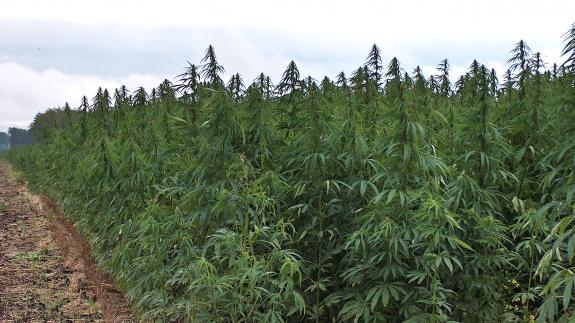Hemp regulations on test drive for 2020
USDA works to balance requests from industry and statutes laid out in 2018 farm bill in establishing new hemp regulatory framework.

The U.S. Department of Agriculture quickly came together in the fall of 2019 to lay out the Establishment of a Domestic Hemp Production Program interim final rule, and now the work begins to balance the requests of the more than 4,600 comments received with what is required by statute under the 2018 farm bill and what USDA’s Agricultural Marketing Service (AMS) may be able to accommodate in regulatory action.
In a call on Feb. 6, USDA administrators shared that interest in hemp from farmers across the country remains high, and they’ve worked hard to offer a program in time for the upcoming growing season. AMS administrator Bruce Summers said it has been “all hands on deck coordinating with other USDA agencies” to quickly develop rules so they’ll be in place for 2020. They intend to reopen the interim rule after the first growing season to capture feedback from actual experiences and develop the final regulations, which must be completed within two years.
The 2018 farm bill defines industrial hemp as “Cannabis sativa L. and any part of that plant … with a delta-9 tetrahydrocannabinol (THC) concentration of not more than 0.3% on a dry weight basis.” The comment period recently closed, and one of the most commonly mentioned concerns is the mandated 0.3% THC level. The interim final rule requires that hemp be tested not only for delta-9 THC but also for THC acid (THCA). The American Farm Bureau Federation said in its comments that this approach has the potential to artificially cause a “hot crop” outside the definition of industrial hemp, risking crop destruction even as the delta-9 THC level, as defined in the 2018 farm bill, is below the 0.3% threshold.
On the call, Summers said USDA has no wiggle room to change that 0.3% level, but because of how it was legislated in the farm bill, it would require an act of Congress to make a change. The National Association of State Agricultural Departments (NASDA) and the Farm Bureau both support setting the negligence threshold for THC at 1%, and NASDA added that it wants to allow states to develop mitigation plans. Comments from the Iowa Department of Agriculture & Land Stewardship called for an increase of the negligent violation range from 0.3-0.5% to 0.3-2.0% THC.
Summers said although USDA does not have much flexibility on THC levels, it does have some flexibility on testing and sampling procedures, the timing and sampling of different plant parts and possibly some discretion on laboratories for testing, although that may also be fairly narrow.
Summers said USDA heard “loud and clear” the concerns regarding the testing in the currently defined 15-day window, and they’re “actively working” on it right now. The interim final rule requires the collection of plant samples needed for THC testing within 15 days of the anticipated harvest date.
In comments to USDA, the Farm Bureau noted that this narrow window places an unnecessary burden on farmers, who risk losing their entire crop if they cannot complete harvest in just 15 days, and fails to consider the potential for delayed test results due to a lack of THC testing facilities. The Farm Bureau is urging USDA to extend the 15-day window to 45 days before the anticipated harvest date to remove this unfair and expensive burden on farmers.
NASDA’s comments suggested extending the number of days in the testing window to within 15-30 days of harvest, and the Iowa department suggested extending the sampling and harvest timeline from 15 days to 21 days.
USDA requires that all THC testing labs be certified by the U.S. Drug Enforcement Administration (DEA). With only 44 DEA-certified labs in 22 states to serve hundreds of hemp farmers, many believe testing delays and backlogs are inevitable. Without a certified lab in each state, hemp growers may have to transport untested samples across state lines to comply with the regulations. However, if the hemp being transported is above the 0.3% THC threshold, farmers will have shipped an illegal product across state lines, opening them up to potential prosecution.
Many states have used private labs with third-party certification to conduct THC testing, based on guidelines in the 2014 farm bill. These labs are regularly assessed and must meet international performance requirements to maintain certification. The Farm Bureau is requesting that USDA allow testing in private labs that have obtained third-party accreditation to minimize delays and costs to hemp farmers.
NASDA suggested dropping the requirement for states to use a DEA-registered laboratory and enhancing flexibility to secure testing in laboratories that have the technical expertise to perform testing on hemp. NASDA also suggested creating a tier-based approach for sampling and testing that would provide greater flexibility for state regulators while assuring the integrity of hemp programs.
The Farm Bureau is requesting that USDA allow THC testing of the entire plant -- including the flower, leaf and stem -- to be averaged together. Since hemp’s legalization, there is growing demand for hemp fibers to make everything from clothing to rope and flooring, none of which is affected by the THC level.
For disposal of non-compliant crops, the interim final rule requires DEA or another entity authorized to handle marijuana under the Controlled Substances Act, which will dictate the process for disposal. The Farm Bureau said this will likely create unnecessary and costly burdens on both farmers and the states and tribes managing industrial hemp programs. Allowing simpler, more timely and cost-effective methods for disposal overseen by state agriculture departments and law enforcement agents would provide greater flexibility and minimize burdens on the regulators and farming community. Additionally, rather than dispose of 100% of a hot crop, the Farm Bureau supports alternative uses of a product that has tested in excess of the established 0.3% threshold so a producer does not lose 100% of the significant investment incurred in planting and growing a hemp crop.
Another issue is how law enforcement may handle crops that transferred or in the event that they must be destroyed. Summers said AMS is working to develop and provide data to law enforcement in real time to provide information on a grower’s hemp license. The 15-day window is also concerning in past situations where a truck was confiscated over fears that it was carrying marijuana and was able to go to a DEA testing facility across state lines. NASDA suggested that USDA allow states to work with state law enforcement instead of DEA to establish protocol for disposal of non-compliant materials.
USDA has 60 days to review and provide feedback for all states wishing to establish their own state plans. Currently, 13 states have had their plans approved.
“We know at least 30 states will have to revise their own laws in order to comply with the requirements of the rule. Without some flexibility, this could exacerbate competitive differences between the states and hamper growth of the national industry,” NASDA chief executive officer Dr. Barb Glenn said.
About the Author(s)
You May Also Like




